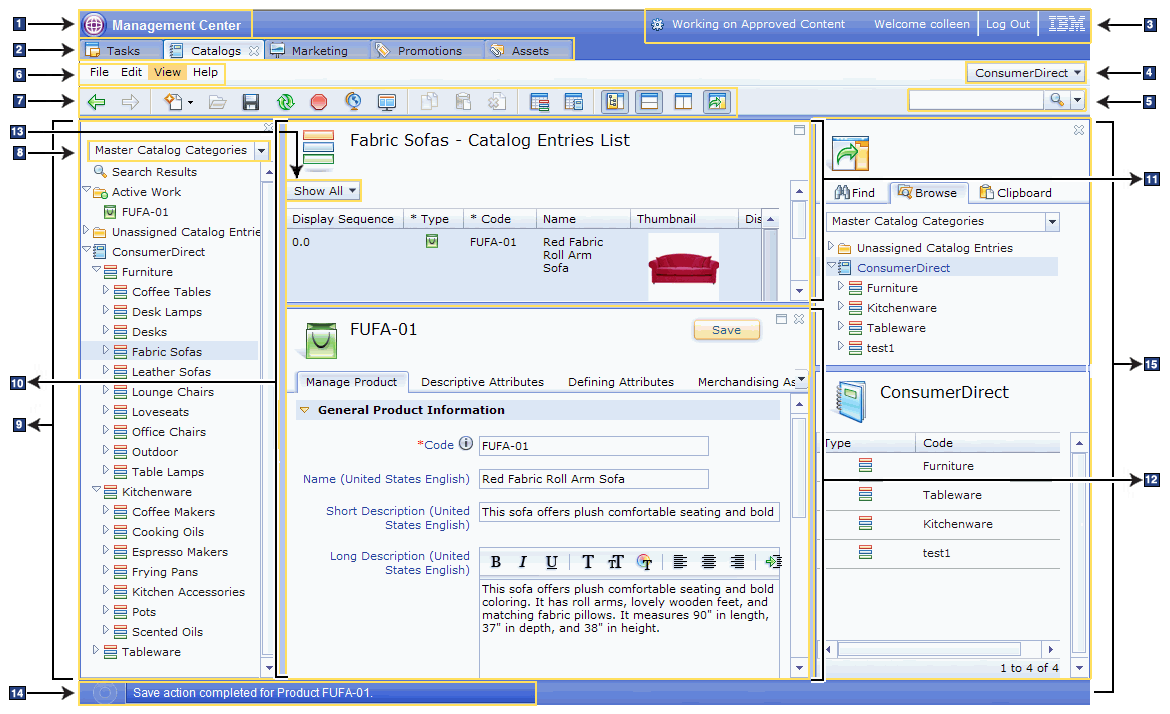Operate > IBM Management Center for WebSphere Commerce
Management Center user interface
The Management Center user interface provides a usable, intuitive, and efficient way to complete the business tasks.
Here is the Management Center user interface at a glance:

Each part of the Management Center user interface is defined below:
- 1 Management Center menu
- Use this menu to open the Management Center Catalogs, Promotions, Marketing, Assets, Installments, and Tasks tools. You can also open the Preferences dialog and access the Getting Started from here.
- 2 Tool tabs
- Each Management Center tool opens in a separate tab; that is, if you have all tools open, you would see the following tabs: Catalogs, Promotions, Marketing, Assets, Installments, and Tasks.
- 3 Banner
- The banner is the top area or header of the user interface, and identifies the Management Center user, the log out link, and the branding logo. This area also displays the names of the task and workspace when you are working on a task or content.
- 4 Store list
- Switch to another store by selecting the down arrow next to the current store name. This list also contains a search option, which you can use to find a store.
- 5 Find area
- Search for objects by typing a keyword and selecting a search object type from a list. You can also select the advanced search option to refine the search.
- 6 Menu bar
- The Management Center includes four menus within the menu bar: File, Edit, View, and Help. All actions supported by the Management Center are within the menu bar.
- 7 Toolbar
- Click a button on the toolbar to quickly perform a task. The toolbar actions are a subset of the most common tasks you can perform using the Management Center.
- 8 Explorer filter
- Within the Catalogs tool, you can filter the explorer view to display the top-level object.
- 9 Explorer view
- The explorer view allows you to navigate the objects with which to work. The entire frame is the explorer view. You can expand and collapse the nodes in the explorer tree to view and work with objects. For example, you can expand a catalog until you reach the catalog SKU level. The explorer view always includes the Search Results node (to allow you to return to a list of results at any time) and Active Work node (to show the objects you currently have open).
- 10 Main work area
- The Management Center main work area is controlled by what you have selected in the explorer view and is displayed in the middle (largest) area of the user interface. The main work area can display information in three views: list view, properties view, or calendar view. You can also split the main work area (horizontally or vertically) so that you can see two views at once.
- 11 List view
- One of the three views displayed in the main work area. A list view lists objects in the form of a table. You can view the list and select a specific row to see more details. You can also reorder, hide, show, or resize columns. If information is editable, you can click the cell and edit on the spot.
To make multiple changes throughout a table more efficiently, you can update several cells in the same column at once with the same value.
- 12 Properties view
- One of the three views displayed in the main work area. A properties view shows details about an object and is where you can edit the object. The properties view can contain entry fields, check boxes, radio buttons, lists, tables, pull-down sections, and tabs. You access the properties view from either selecting to create a new instance of an object, or by selecting an existing object from a list view.
- 13 List view filter
- You can filter a list view to display only specific information. For example, list only SKUs, or list everything but SKUs for the catalog.
- 14 Status bar
- The status bar is the bottom area or footer of the user interface, and includes messages, access to the message console (by clicking ), and a progress indicator.
- 15 Utilities view
- The utilities view allows you to locate and use objects that to reference or use with the current object, without navigating away from the current view. For example, while editing a product, to include a reference to another product as a cross-sell item. Use the utilities view to search for merchandising association items, and then drag an item from the utilities view to the merchandising association tab of the source product. The utilities view includes three functions: search (to find objects by a system search), browse (to find objects by looking within a directory structure or hierarchy), and clipboard (a container to hold objects for later use).
- Management Center icons
The Management Center toolbar button icons provide a subset of the most common tasks you can perform using the Management Center.
Related tasks
Related reference
Management Center keyboard shortcuts